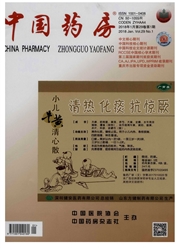

 中文摘要:
中文摘要:
目的:为建立适用于多院区的临床药学实践工作模式提供参考。方法:基于我院2012-2013年临床药学发展的环境、工作内容及取得的成效,总结在院区分散、信息化程度提高和药学人力资源不足的情况下开展临床药学工作的经验。结果:我院的实践模式包括药师培养专科化、临床实践专业化,临床药师日常工作量化管理,临床药学服务与参与质量综合目标管理一体化,充分利用信息技术进行临床合理用药监测,实现处方点评靶向化。该模式实践后,2013年住院患者抗菌药物使用率为56.6%,抗菌药物用药频度也由2012年的45下降到41,抗菌药物病历微生物标本送检率达30.2%,眼科医院围术期抗菌药物预防使用率从90%下降至10%以下;上报药品不良反应报告271份,增长率为33.58%。结论:建立的模式促进了临床合理用药和用药安全。
 英文摘要:
英文摘要:
OBJECTIVE: To provide reference for the establishment of a clinical pharmacy practice mode applicable to the multi-area hospital. METHODS: Based on the environment, work contents, tasks and results of clinical pharmacy development of our hospital from 2012 to 2013, the results and work experience were summarized under dispersed district, higher informationization degree and insufficient human resources. RESULTS:Our hospital have made some practices including specialized training of pharmacists and specialized clinical practice, the quantitative management of the routine work of clinical pharmacists, the integra- tion of clinical pharmacy services and participation in comprehensive medical quality management by objectives, informationized drug use monitoring and targeted comment on prescriptions. After the exploration and application of this model, in 2013, the rate of antimicrobial drug use of the inpatients was 56.6%; the DDDs of antimicrobial drug was decreased to 41 from 45 in 2012; the sub-mission rate of antibiotic microbial specimen was reached 30.2% ; the rate of antimicrobial drug use for prophylaxis on periopera- tive period of the ophthalmic hospital was decreased from 90% to 10% or less; 271 cases of adverse drug reactions were reported with increase rate of 33.58 %. CONCLUSIONS: The established mode has promoted the rational and safe drug use in clinic.
 同期刊论文项目
同期刊论文项目
 同项目期刊论文
同项目期刊论文
 期刊信息
期刊信息
